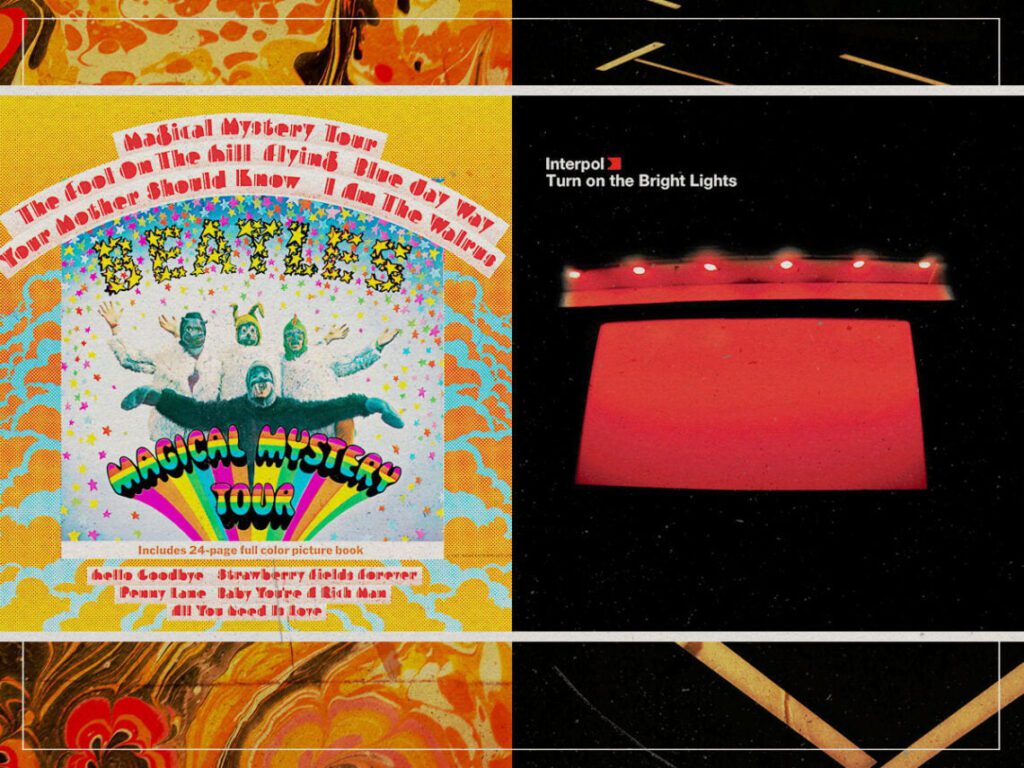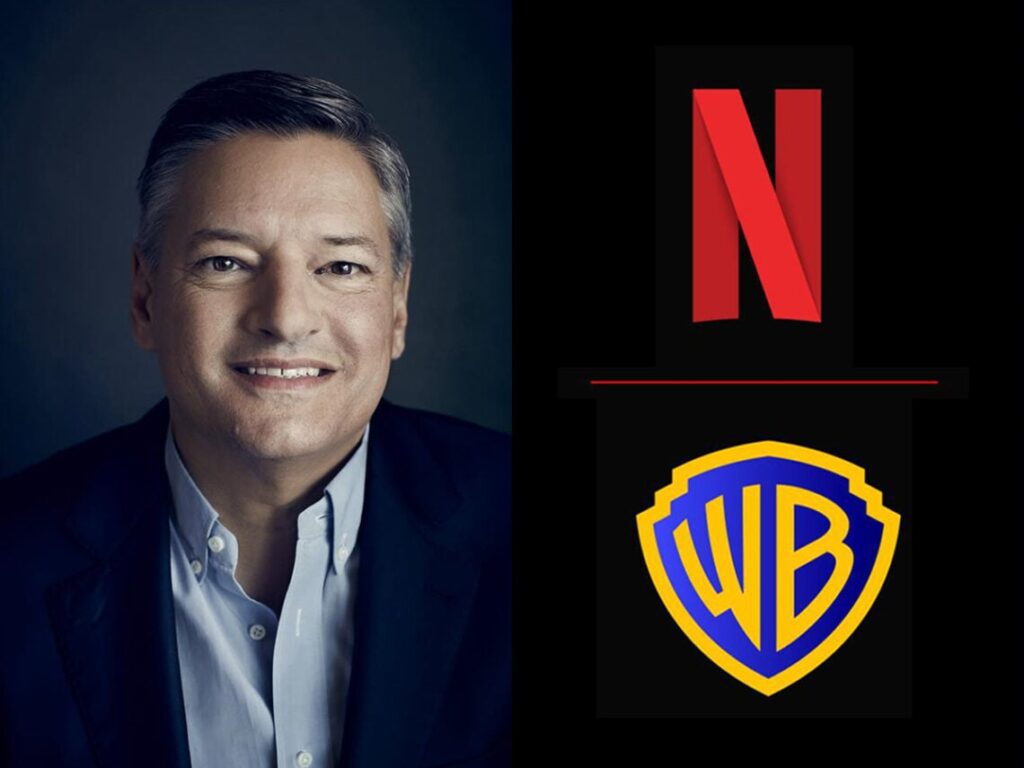The hauntology of ‘Magical Mystery Tour’ vs ‘Turn on the Bright Lights’: Two masterpieces half a century apart
 Posted On
Posted On
(Credits: Far Out / Apple Corps / Matador Records)
Since reading the studies of Mark Fisher, the late pioneer of analysing hauntology’s place in culture, a line has been endlessly tossed around and mutated in my mind. I will paraphrase it thus: these days, nobody reasonably expects that another band will ever come along as big as The Beatles. Even for an optimist who sings the praises of new music on a daily basis for a living, that concept seems irrefutably and unbearably true. While, like millions of men before me, I have told myself that size isn’t everything, it would still be thrilling to see a behemoth new band come along and similarly transcend society.
Alas, that seems like an impossibility. For the uninitiated, that sense that the future holds dwindling returns and the past looms larger than ever before is pretty much what ‘hauntology’ means in a nutshell. However, the intriguing fact of the matter remains that contrary to what you might assume, by and large, this has little to do with quality. The reason that bands of The Beatles’ ilk are bygone is far more nuanced than that. The actual substance of the art has little to do with it, in fact.
A case in point can be found with Interpol’s debut album, Turn on the Bright Lights. By any measure, the LP is a masterpiece. It arrived almost exactly a year after the tragedy of 9/11 befell the band’s native New York City. This cataclysm irrevocably changed the world, shocking it into a new era. While Turn on the Bright Lights might not literally address the terrorist attack, it most certainly deals with the aftermath. It reconciles the changes that unspooled in the society around the band. It mimics the brooding despair with a dark and maleficent sound while finding a wellspring of soaring defiance in the indie scene that co-exists as key changes of hope in the anthemic tunes.
However, the album charted at 158 in the US and 101 in the UK. Even most of the critical praise it has received has been a slow gathering rise of retrospect. Moreover, while it might now be considered a modern classic, that is merely in the regard of a niche clique. If you ask 100 random people on any given western street to name their favourite song from Turn on the Bright Lights, you’d be lucky to get a single valid response. The album holds no ground in wider society beyond the footnote that a few folks into indie thought it was great.
How can that be? How can an album that innovated a brand-new sound that seemed to perfectly match the mood of the world in the unfurling backwash of an untold disaster be rendered moot beyond a small coterie of hipsters who seem to think that it is simply one of the best albums of the century and nothing more? Even that in itself is an oxymoron, whereby we’re strangely blasé about the very best of our era.
Well, while that question might be profound, the answers seem plain enough. We’ve encountered masterpieces and disasters countless times before. Although the visual nature of 9/11 may well have made it shocking in the extreme, such instances were, in fact, nothing new to the modern world. Only six years earlier, far-right terrorists blew up the Federal Building in Oklahoma City, killing 168 people. And while the 9/11 fatality toll of 2,996 might be far more devastating, brutal loss of innocent life was something previous generations had already reckoned with during the Vietnam War, where it is estimated that 84,000 children were killed, not to mention the fact that many of those classified as adults were merely above the age of 15.
This leads us on to Magical Mystery Tour, a masterpiece that looms large in the present and holds a far more significant mantle in our cultural history. This manic album arrived amid manic times. The hectic preamble to the release is exactly why it seems strange to couple The Beatles and Interpol in the same discussion. Magical Mystery Tour isn’t even considered the band’s best, but the events surrounding it still place it on an unimpeachable pedestal that Interpol’s finest effort can’t match.
Almost exactly four years prior to the release, televised footage of a President’s head being blown off in Dallas became the most shocking broadcast in history. A few months later, the Fab Four landed, filling a rock ‘n’ roll void that had opened a few years earlier on the Day the Music Died, whereby a plane crash took the lives of a generation’s finest musical talents, artists such as Buddy Holly, Ritchie Valens and The Big Bopper all perished at once. They happened to touch down at a time when America was in dire need of musical exultancy, hence the ensuing Beatlemania.
At almost the exact same time, Bob Dylan had amplified music’s intent to be a more serious and poetic tannoy with the release of The Times They Are a-Changin’. Within weeks, the importance of that point would be made all the more apparent after three Civil Rights workers were murdered in Mississippi, galvanising the movement amid ripples of despair. A few weeks after that, the US retaliated to an attack by North Vietnam on one of their destroyer ships stationed in the Gulf of Tonkin, escalating their involvement in Indochina into a full-blown war.
This resulted in American youth being shipped off in their droves to die in a war that most didn’t even agree with. Riots erupted in response. These intensified when Malcolm X was shot dead. Meanwhile, LSD would be rendered legal through a loophole. The pill gave birth to free love. Television, radio, and vinyl would all become widespread for the first time, and electricity would be available in many parts of the world. A freaking space race was kicking off. The Beach Boys pioneered a new advancement in stereo-sound with Pet Sounds, changing the way music would be created forevermore and penning hitherto unknown keyless Baroque pop masterpieces like ‘God Only Knows’.

All of this culture was brand-new, innovative and had never been seen before. The backdrop, likewise, was brand-new, biblical and more vivified than anything that had been seen before. The kids, raised in the hopeless scourge of the Second World War, were chasing down a revolution, while those that stood against them were reconciling a world gone awry as ever-gaudier headlines garnered gasps en masse from an increasingly involved public. Perhaps above all, it seemed clear that the technological fix was not the unfurling miracle of the future that it once promised to be, despite replacing God in an increasingly secular world as it was ceaselessly rolled out, sending millions into a thankless factory existence, and gobbling up beautiful green space with brutalism.
That, it must be said, is quite an environment to be releasing an album into—albums, which, by the way, had only been popular for about a decade and widely affordable for even less time. The novel buzz of an actual cultural revolution catapulted the arts to significant heights, resulting in a renaissance period written about in glowing terms for centuries to come. That is not to diminish the magnitude of the artists of the time themselves. It’s hard not to look at Dylan breaking new ground by pairing folk with rock on Bringing It All Back Home, one of the greatest albums of all time, and following that up a mere six months later with the release of Highway 61 Revisited, another of the greatest albums of all time, and not think that there was something creatively concurrent in the water too.
However, the goals that these masterful musicians were scoring into were open. It was a case of getting your shot off first. If you scored, there was a generation waiting with open ears to have their mind by your Promethean wallop. A case in point is the strange legacy of ‘I Am the Walrus’. This was a song that I knew about in primary school despite being born decades after its release.
There is no way that a song inspired by the sexual kinks of Eric ‘The Eggman’ Burdon, a working-class Geordie singer, transmuted in the drug-addled mind of John Lennon, run through a ringer of an avant-garde collision of rock and classical orchestration, taking on the ground-breaking compositional structure of a harmonic Moebius strip, should reasonably expect to be a hit that lives on for centuries. It is mind-bendingly experimental and innovative, a million miles from the typical mainstream, and yet, in direct contrast to any given lyric from Turn on the Bright Lights, you say to 100 members of the public, “I am the walrus,” and most will likely reply, “goo-goo-ga-chu” – whatever that means.
However, as Marcel Duchamp had demonstrated some 50 years earlier, if the times were mad, then art should follow suit. So, the berserk and novel nature of ‘I Am the Walrus’ seems oddly fitting. Unprecedented times call for unprecedented music. The public recognised this and lapped it up, the brilliance of the art serving as a balm to the brutally bombastic world. If anything, revolutionary anthems like ‘Strawberry Field Forever’ showcased that there was still a sentiment to be found somewhere in the technological future.
From then on, the times have barely changed, and that hope has all but evaporated. The masterpieces and disasters that spawn them have not stopped, but the sheer amount of them has led to diminishing returns when it comes to our response to both. New novelties may have arisen, but we’re still bending on the same arc of human history that arose as a diegesis around the time of Magical Mystery Tour.
The make-up of society and its stark divisions remain. You only have to look at the fact that when the National Guard opened fire on unarmed protesters at Kent State University in Ohio in 1970, killing four, the poll that followed found that a little over half of America said those who were killed pleading for peace were to blame. This startling result offers up the retrospective realisation that no matter how much we tell ourselves, trying to find a discreet angle for these murky modern times, we’re no more polarised than we ever have been before. As ever, music, in turn, tries to make some sort of sense of this.
Presently, the trend seems to be a dissolution of the genre – a novel advancement, but one that is nevertheless underpinned by the sense that it is a response to everything great that has come before, purely by virtue of timing. The strides we now search for in music are no great leaps for mankind but curious little sidesteps into a sacred inch of something new amid a sea of what has already been done before. Often, in response to an unchanging tide, that means only our attitude to modern music is altered as we fail to imbue greatness with a sense of glory. We once held a hope that ‘All You Need is Love’ really might change the world. Now we know otherwise and just quietly posit that Interpol did a good job instead.
We have now become apathetic about future innovations in the arts. Inventions like VR, Google Glasses, and even VAR in sports, have widely been met with the consensus: ‘You know what, I’d rather not, I’m actually quite content with what was cooked up in the 1960s.’ The impact of this reverence of the past is that culture seems to have slowed. Magical Mystery Tour is now closer to the pomp of Vaudeville shows in the 1910s and a time when less than 5% of houses had electricity than it is to the present. Yet it doesn’t feel that way at all. The record seems to have stopped ageing, shuffling closer to today, towering over newer masterpieces like Turn on the Bright Lights as it does so—a record comparable, if not better, in terms of objective quality, yet quashed tenfold by circumstance.
[embedded content]


